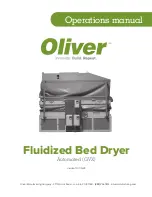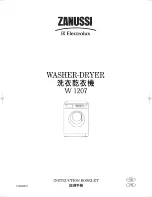
16
American Dryer Corp.
113363 - 37
When single dryer venting is used, the ductwork from the dryer to the outside exhaust outlet should not
exceed 20 feet (6.09 meters). In the case of multiple (common) dryer venting, the distance from the last
dryer to the outside exhaust outlet should not exceed 20 feet (6.09 meters). The shape of the ductwork
is not critical as long as the minimum cross-sectional area is provided. It is suggested that the use of 90°
turns be avoided; use 30° and/or 45° bends/angles instead. The radius of the elbows should preferably
be 1-1/2 times the diameter of the duct. Excluding tumbler/dryer elbow connections or elbows used for
outside protection from the weather, no more than two (2) elbows should be used in the exhaust duct run.
If more than two (2) elbows are used, the cross-sectional area of the ductwork must be increased in
proportion to the number of elbows used.
ALL ductwork should be smooth inside with no projections from sheet metal screws or other obstructions,
which will collect lint. When adding ducts, the duct to be added should overlap the duct to which it is to be
connected. ALL ductwork joints must be taped to prevent moisture and lint from escaping into the
building. Inspection doors should be installed at strategic points in the exhaust ductwork for periodic
inspection and cleaning of lint from the ductwork.
NOTE: When the exhaust ductwork passes through a wall, ceiling, or roof made of combustible
materials, the opening must be 2-inches (5.08 cm) larger than the duct (all the way around).
The duct must be centered within this opening.
IMPORTANT: Exhaust back pressure measured by a manometer/magnehelic in the exhaust duct
must be no less than 0 and must not exceed 0.3 in WC (0.74 mb).
NOTE: It is recommended that exhaust or booster fans not be used in the exhaust ductwork system
except where necessary to maintain exhaust back pressure (in the exhaust duct) between zero
and 0.3 inch water column. Where employed, booster fans must not activate the dryer airflow
proving switch (sail switch) when the dryer is not in operation.
NOTE: As per the National Fuel Gas Code, “Exhaust ducts for type 2 clothes dryers shall be
constructed of sheet metal or other noncombustible material. Such ducts shall be equivalent in
strength and corrosion resistance to ducts made of galvanized sheet steel not less than 26
gauge (0.0195-inches [0.50 mm]) thick.”
Outside Ductwork Protection
To protect the outside end of the horizontal ductwork from the weather, a 90° elbow bent downward
should be installed where the exhaust exits the building. If the ductwork travels vertically up through the
roof, it should be protected from the weather by using a 180° turn to point the opening downward. In
either case, allow at least twice the diameter of the duct between the duct opening and the nearest obstruction.
Содержание ML-122
Страница 52: ...ADC Part No 113363 37 09 20 21 ...
















































